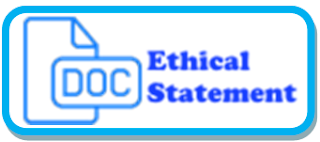Literary Warrant dan User Warrant untuk Merancang Konstruksi Prototipe Tesaurus
Abstract
A thesaurus limits its scope to specific subjects or related to certain subjects and is a means of standardizing terms created as a tool in the process of organizing information. A principle-compliant index language is required when organizing information. A user warrant and literary warrant approach can be used to construct a thesaurus with a particular subject. User warrant means the collection of terms based on users’ frequency of use of a term, while the literary warrant is carried out with an accurate survey of a word, phrase, or term contained in literature. The results of the analysis in the form of a thesaurus prototype can be used as a tool for document indexing and information retrieval. This becomes a tool for classifying and finding collections in the library as collections with various subjects grow. A thesaurus is a form of means of supervising controlled terms post-adjustment or post-coordination. In constructing the thesaurus, an arrangement of entries is formed to show equivalence relationships, hierarchical and associative. The results of the subject thesaurus construction can be used as a basis for further thesaurus development, which is more complete for the indexing process.
Keywords
Full Text:
PDFReferences
Aitchison, J. & Clarke, S.G.D. (2004). The Thesaurus: A Historical Viewpoint, with a Look to the Future. Cataloging & Classification Quarterly, 37(3-4), 5-21. https://doi.org/10.1300/J104v37n03_02
Aitchison, J., Gilchrist, A., & Bawden, D. (2000). Thesaurus Construction and Use: A Practical Manual. 4th Edition. London: Aslib IMI.
Azzahra, D. F. N., & Nugraheni, A. S. (2021). Aplikasi Tesaurus Indonesia Sebagai Solusi Mengatasi Minimnya Penggunaan Kosakata Dalam Menulis. Caraka: Jurnal Ilmu Kebahasaan, Kesastraan, dan Pembelajarannya, 8(1), 107–126. https://doi.org/10.30738/ca.v8i1.11486.
Barite, M. (2018). Literary Warrant. Knowl. Org. 45(6), 517-536. https://doi.org/10.5771/0943-7444-2018-6-517
Beghtol, C. (1986). Semantic Validity: Concepts of Warrant in Bibliographic Classification Systems. Library Resources & Technical Services, 30(2), 109-125.
Beghtol, C. (1995). Domain Analysis, Literary Warrant, and Consensus: The Case of Fiction Studies. Journal of the American Society for Information Science, 46(1), 30-44. https://doi.org/10.1002/(SICI)1097-4571(199501)46:1<30::AID-ASI4>3.0.CO;2-F
Chowdhury, G. G. (2010). Introduction to Modern Information Retrieval. London: Facet Publishing.
Clarke, S. G. D & Zeng, M. L. (2012). Standard Spotlight: From ISO 2788 to ISO 25964: The Evolution of Thesaurus Standards Towards Interoperability and Data Modeling. In: ISQ Information Standards Quarterly, 24(1), 20-26. https://doi.org/10.3789/isqv24n1.2012.04
Cochrane, P. (1993). Warrant for Concepts in Classification Schemes. Proceedings of The 4th ASIS SIG/CR Classification Research Workshop, 57-68. https://doi.org/10.7152/acro.v4i1.12611
Coyle, K. (2012). Vocabularies: Term Lists and Thesauri. Library Technology Reports, 48(4), 27-35. https://journals.ala.org/index.php/ltr/article/view/4670/5541
de Miranda Guedes, R. & Moura, M. A. (2018). Semantic Warrant, Cultural Hospitality and Knowledge Representation in Multicultural Contexts: Experiments with The Use of The EuroVoc and UNBIS Thesauri. Advances in Knowledge Organization, 16, 442-449.
Dykstra, M. (1988). LC Subject Headings Disguised as a Thesaurus. Library Journal, 113(4), 42-46.
Esh, M. & Ghosh, S. (2023). A Twenty-Year Trend Analysis of Literary Warrants on Digital Literacy and Digital Competency Through SCOPUS Database. Science and Technology Libraries. https://doi.org/10.1080/0194262X.2023.2238222.
Federal Council for Science and Technology (U.S.). Sub-panel on Classification and Indexing. (1967). Guidelines for the Development of Information Retrieval Thesauri. Washington, D.C: COSATI.
Gomes, P. & Da Cunha Frota, M. G. (2019). Knowledge Organization, 46(8), 639-646. https://doi.org/10.5771/0943-7444-2019-8-639.
Lancaster, F. W. (1986). Vocabulary Control for Information Retrieval. 2nd Edition. Arlington, Va: Information Resources Press.
Levine-Clark, M. & Carter, T.M. (2013). ALA Glossary of Library and Information Science. 4th Edition. United States of America: American Library Association.
Lisbdnetwork (2018). Thesaurus: An Overview. Tersedia di https://www.lisedunetwork.com/thesaurus-an-overview/
Literary Warrant (and Other Kinds of Warrant). Tersedia di http://arkiv.iva.ku.dk/kolifeboat/CONCEPTS/literary_warrant.htm#
Losee, R. (2015). Thesaurus Structure, Descriptive Parameters, and Scale. Journal of the Association for Information Science and Technology, 67(9), 2156-2165. https://doi.org/10.1002/asi.23544
Luhn, P. Tanpa Tahun. Thesauri: Introduction and Recent Developments. (Chapter 1). Tersedia di https://books.infotoday.com/asist/Powering-Search/Sample-Chapter.pdf
Mitchell, J. (2001). Relationships in the Dewey Decimal Classification System. In: Relationships in The Organization of Knowledge. Dordrecht: Kluwer Academic Publishers.
National Information Standards Organization (NISO). (2010). Guidelines for the Construction, Format, and Management of Monolingual Controlled Vocabularies. https://groups.niso.org/apps/group_public/download.php/12591/z39-19-2005r2010.pdf
National Information Standards Organization (NISO). (2011). ISO 25964 The International Standard for Thesauri and Interoperability and Other Vocabularies. http://www.niso.org/schemas/iso25964
Ogg, N. J., Sievert, M., Li, Z. R., & Mitchell, J. A. (1994). Contruction of a Medical Informatics Thesaurus, 900-904.
Perpustakaan Nasional RI. (2018). Daftar Tajuk Subjek Perpustakaan Nasional. Jakarta: Perpustakaan Nasional RI.
Pey B, Laporte M-A, Nahmani J, Auclerc A, Capowiez Y, Caro G, et al. (2014). A Thesaurus for Soil Invertebrate Trait-Based Approaches. PLoS One, 9(10). https://journals.plos.org/plosone/article?id=10.1371/journal.pone.0108985
Prytherch, R. (2005). Harrod’s Librarians’ Glossary and Reference Book: A Directory of Over 10,200 Terms, Organizations, Projects and Acronyms in the Areas of Information Management, Library Science, Publishing and Archive Management. 10th ed. Aldershot: Ashgate.
Purdy, C. (2011). Visual Thesaurus 2.0, IDG Communications/Peterborough, San Francisco. https://www.macworld.com/article/168361/visualthesaurus2.html
Riesthuis, G. (2005). Book Review of: ASIS&T Thesaurus of Information Science, Technology, and Librarianship. 3rd ed. Medford, N.J.: Information Today. Knowledge Organization, 32(4), 159-160.
Ryan, C. (2014). Thesaurus Construction Guidelines: An Introduction to Thesauri and Guidelines on Their Construction. Dublin: Royal Irish Academy and National Library of Ireland. https://doi.org/10.3318/DRI.2014.1.
Sulistyo-Basuki. (2004). Pengantar Dokumentasi. Bandung: Rekayasa Sains.
Wu, L., Liu, Q., Zhao, G., Huang, H., & Huang, T. (2015). Thesaurus Dataset of Educational Technology in Chinese. British Journal of Educational Technology, 46(5), 1118–1122. https://doi.org/10.1111/bjet.12298.
DOI: https://doi.org/10.18326/pustabiblia.v7i2.127-138
Refbacks
- There are currently no refbacks.
Copyright (c) 2024 Pustabiblia: Journal of Library and Information Science

This work is licensed under a Creative Commons Attribution-NonCommercial-NoDerivatives 4.0 International License.
===========================================================================
Perpustakaan Institut Agama Islam Negeri (IAIN) Salatiga
Jl. Lingkar Salatiga Km. 2 Pulutan, Sidorejo,
Kota Salatiga, Jawa Tengah 50716,
Telp. (0298) 323706 – Fax. (0298) 323433
===========================================================================
Technical Support:Email : wiji.suwarno@gmail.com
Phone : +62 819-1433-5525



